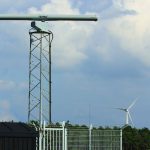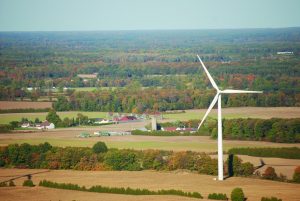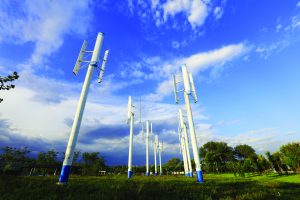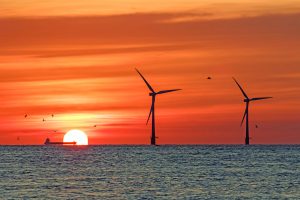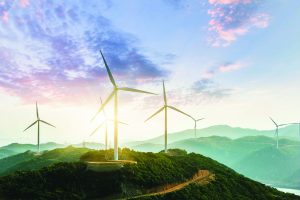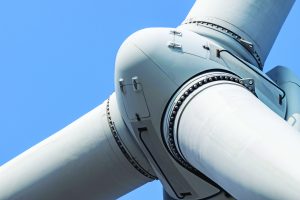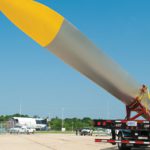Introduction
According to data from the American Wind Energy Association, wind energy supplied more than 4 percent of the United States’ electricity in 2013. On the state level, in 2013, wind energy had double-digit percentage shares in nine states. In Iowa and South Dakota, wind energy provided more than 25 percent of those states’ electricity.
The U.S. wind industry installed 214 MW during the first quarter of this year, eclipsing total new capacity installed in the first three quarters of 2013. The U.S. now has a cumulative installed wind capacity of 61,327 MW. Currently, more than 13,000 MW of wind projects are under construction — an industry record. Figure 1
Despite a significant drop in new installed capacity in 2013, wind energy is continuing to expand its share of the U.S. energy generation mix.
Need and Opportunity
In 2008, shortly before the exponential growth of the U.S. wind energy industry, installed capacity was 25,065 MW. Kalamazoo Valley Community College saw an opportunity to address the long-term need for highly qualified wind energy technicians. Administrators and personnel recognized and understood the need for technicians who could perform services and make repairs as well as contribute to the industry’s need for improved efficiencies and availability. In 2009, KVCC enrolled students and launched its Wind Turbine Technician Academy (WTTA) with the intent of changing the paradigm for educating the wind workforce.
The Program
Kalamazoo Valley’s Wind Turbine Technician Academy attracts students who want to be the best in their field. Applications are required to assure students understand the working conditions, the complexity of the job and embrace the requirements associated with wind farm locations. Students who are accepted into the course are climb-tested, undergo background checks and take a skills assessment. Figure 2
Many students are attracted to the field as a proactive opportunity to support clean energy production and by the unique opportunity to work on highly advanced technology. Students come from around the world and alumni can be found at work for nearly all of the major wind industry employers. Workforce placement rates have remained between 95 – 97 percent for certified alumni.
This program has an elite reputation of being a responsive program driven by industry demands. That fact is largely due to its competency-based programming which aligns to skill standards created by employers. This month, the tenth WTTA class begins its study in the 24-week course. Students attend the program Monday through Friday, eight hours a day, to gain proficiency in specific competencies and in performing actual work demonstrating their ability to apply what they learn.
Kalamazoo Valley Community College holds the recognition of earning both the American Wind Energy Association (AWEA) Seal of Approval, as well as certification by the Bildungszentrum für Erneuerbare Energien (BZEE), Renewable Energy Education Center. As a BZEE partner school, graduates have the opportunity to earn a certification as a Service Technician for Wind Turbine Engineering. Certification requires students to pass both written and practical examinations, as well as participate in in-the-field service to satisfy internship requirements.
Hands-On Training
The training lab is located in Kalamazoo, Michigan. This is a hands-on program. The first three weeks of the course is devoted to certified safety training. The program has earned the respect of wind farm owners such as Michigan-based Crystal Flash Renewables and Heritage Sustainable Energy, who support the program through educational affiliations. These partnerships afford students the opportunity to gain hands-on experience by performing real work on real working turbines — under the guidance of their professional instructional team. This experiential learning fulfills the certification requirements of the BZEE and produces experienced, well-tested graduates who are immediately prepared to perform the job functions required by their future employers. Figure 3
“As an owner/operator of utility wind facilities, we place tremendous faith in not only the skill, but also the dedication of the technicians,” said Rick Wilson, Vice President of Operations at Heritage Sustainable Energy, located in Traverse City, Michigan. “They are responsible for millions of dollars of equipment and assuring that it is available when the wind blows 24/7/365. The Kalamazoo Valley program instills this sense of responsibility in the students and heightens their level of enthusiasm to execute their job with the utmost efficiency.”
Growing Demand
With the push in this country to generate 20 percent of our energy with wind by 2030, the demand for highly trained technicians will only increase. (Technicians starting pay ranges from $16.50 to 24.00 per hour. Overtime is common.) The work requires technicians to be willing and able to travel at the direction of their company. The work follows service contracts that cover predicted maintenance as well as unplanned service. Industry estimates call for one wind turbine technician is needed for every ten turbines.
The need for technicians will continue to increase regardless of the market associated with policy debates and inconsistency. The existing fleet will continue to require support. Figure 4
“Our training curriculum is at the leading edge of best practices in the industry,” said Tom Sutton, Director of Wind Energy and Technical Training at Kalamazoo Valley, “We listened carefully to employers and have built a course driven by their training standards. Our reputation for excellence as a competency-based training institution is evidenced by wind energy leaders knowing our graduates personally and attributing their proficiency to the training they received while in the program. By showing it can be done, the industry has made renewed commitments to competency-based training for technicians entering the industry.”
Student Profile/Testimonials
The Kalamazoo Valley WTTA graduated its first class of technicians in 2010. Including the class of 2014 who graduated on June 20, 134 alumni have successfully entered the field of generating renewable energy. Students come from all over the world and they go all over to find jobs. It is truly a global program.
Nick Moss, 23, a recent graduate from the Kalamazoo Valley program, already has a job lined up in Woodward, Oklahoma. A 2014 graduate of the program, Nick feels prepared to begin his career and continue advancing with it. Figure 5
“My last job was a dead-end,” said Moss. “I already had a good mechanical background from working on a farm.” Working at height didn’t intimidate him, but was instead one of the things that drew him in.
“This is a fast-growing industry — I am looking forward to traveling around the country,” he said.
Conclusion
The Kalamazoo Valley Community College Wind Turbine Technician Academy provides a fast track to high demand/high paying jobs. Wind Turbine Technicians are employed by turbine manufacturers and firms that provide operational and maintenance services as well as construction companies. Kalamazoo Valley offers this course as a non-credit full time program allowing men and women the chance to be job ready in less than six months.
“Our hands-on training capability, having trainees in real operating wind turbines, continues to make us attractive to the wind industry employers who see the field experience, combined with strong fundamentals education, as the best way to develop world class technicians,” Sutton said.
The Wind Turbine Technician Academy is offered twice a year. The next academy begins on July 7, 2014.
|
|
(269) 488-4400 |
|
www.kvcc.edu |

















